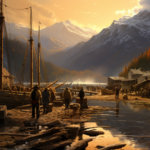In the annals of American history, few events have captured the imagination and shaped the destiny of a region quite like the California Gold Rush. Born out of a chance discovery in the Sierra Nevada foothills, this extraordinary event ignited a frenzy of migration, transformed a sparsely populated territory into a thriving state, and forever altered the course of American history. In this exploration of “The California Gold Rush,” we delve into the origins, impact, and enduring legacy of this remarkable chapter in the nation’s history.

The Spark of Discovery
The California Gold Rush began with an accidental discovery that would set off a chain reaction of events. On January 24, 1848, James W. Marshall, a carpenter working for John Sutter at Sutter’s Mill in Coloma, California, noticed something glistening in the American River. It was a small nugget of gold, and it would change everything.
1. James W. Marshall: Marshall’s discovery of gold was not the first in California, but it was the most significant. He tried to keep it a secret, but news of the discovery quickly spread, setting off a wave of excitement.
2. The Ripple Effect: As word of the gold discovery reached San Francisco, a bustling trading post at the time, newspapers began to report on the find. The news soon reached the East Coast of the United States and even traveled around the world, igniting a frenzy of speculation.
The Great Migration
The California Gold Rush sparked one of the largest migrations in American history, drawing people from all walks of life to seek their fortunes in the West. This migration had profound effects on the United States and the world.
1. “Forty-Niners”: The gold seekers, often referred to as “Forty-Niners” due to the peak year of migration in 1849, came from across the United States and around the globe. They included miners, merchants, adventurers, and even families.
2. Global Impact: The allure of gold reached far beyond American borders. Immigrants from China, Mexico, Chile, Australia, Europe, and other regions flocked to California in search of treasure. This diversity of cultures enriched the state’s social fabric.
3. Transformation of California: The influx of people had a transformative effect on California. Towns sprang up overnight, including San Francisco, Sacramento, and Stockton. San Francisco, in particular, saw its population explode from a sleepy village to a major city.
The Hardships of Mining
While the promise of striking it rich drew thousands to California, the reality of gold mining was arduous and often disappointing. Miners faced grueling labor, harsh conditions, and intense competition.
1. Mining Techniques: Initially, miners used simple tools like picks, shovels, and pans to extract gold from streams and riverbeds. As the easy pickings were exhausted, more sophisticated techniques, including hydraulic mining and placer mining, were employed.
2. Boom and Bust: Mining camps and towns often experienced rapid boom and bust cycles. A town might spring up overnight, only to be abandoned once the gold ran out. Others, like San Francisco, grew into enduring cities.
3. Challenges and Dangers: Mining was physically demanding and perilous work. Miners faced the risk of cave-ins, disease, and violence. Lawlessness was common in some mining towns, earning them the moniker “Wild West.”
The Legacy of the Gold Rush
The California Gold Rush left an indelible mark on the United States and the world, influencing economics, politics, culture, and society in numerous ways.
1. Economic Impact: The Gold Rush injected immense wealth into California and the United States. Gold became a significant source of revenue for the federal government, helping to stabilize the nation’s economy.
2. Population Growth: The influx of people to California contributed to the state’s rapid population growth. By 1850, California was admitted to the Union as the 31st state, and it would soon become the most populous state in the nation.
3. Cultural Diversity: The Gold Rush brought people from diverse backgrounds and cultures to California. This diversity continues to shape the state’s identity and has influenced its cuisine, arts, and traditions.
4. Infrastructure and Innovation: To support the Gold Rush, California saw significant developments in infrastructure, including the construction of roads, bridges, and railroads. The demand for supplies and transportation spurred innovation and investment.
5. Environmental Impact: The environmental toll of gold mining was substantial. Hydraulic mining, in particular, led to widespread ecological damage, including erosion, sedimentation of rivers, and destruction of natural habitats.
The Gold Rush in Popular Culture
The California Gold Rush has been romanticized and immortalized in countless works of literature, film, and art. It remains a symbol of the American Dream and the pursuit of opportunity.
1. Literary Works: Authors like Mark Twain, Bret Harte, and Jack London drew inspiration from the Gold Rush. Twain’s “Roughing It” and Harte’s “The Luck of Roaring Camp” are among the notable literary works set in this era.
2. Artistic Depictions: Painters like Albert Bierstadt captured the beauty of the California landscape, while artists like Charles Nahl and Thomas Hill portrayed scenes of mining camps and daily life during the Gold Rush.
3. Film and Television: The Gold Rush era has been a popular setting for films and television series, including Charlie Chaplin’s “The Gold Rush” and the popular TV series “Bonanza.”
Conclusion: A Golden Chapter in History
The California Gold Rush stands as a testament to the enduring allure of the American Dream. It was an era of optimism, adventure, and hardship, where people from all corners of the world converged on a distant land in pursuit of a glittering dream.
In the wake of the Gold Rush, California emerged as a cultural and economic powerhouse, forever altering the trajectory of the nation. While the pursuit of gold was often challenging and elusive, the legacy of the Gold Rush endures as a symbol of ambition, resilience, and the pursuit of opportunity.
As we reflect on this golden chapter in history, we are reminded of the transformative power of dreams and the indomitable spirit of those who dared to chase them. The California Gold Rush is more than a historical event; it is a testament to the enduring quest for a better life and the remarkable impact that one moment of discovery can have on the course of human history.



